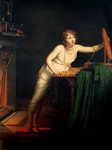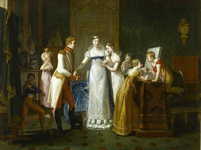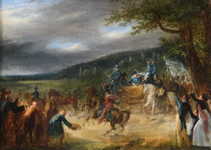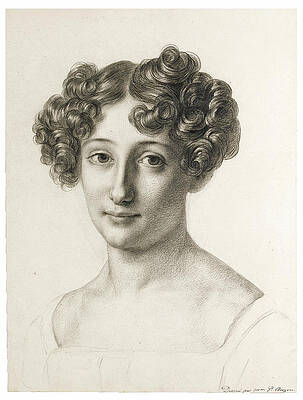Pauline Auzou


Arrival of the Empress Marie-Louise in Compiègne 28 March 1810

Marie-Louise's farewell to her family March 13, 1810
Portrait of a Lady said to be a Self-Portrait


Pauline Auzou (March 24, 1775 – May 15, 1835) was a French French and art instructor, who exhibited at the Paris Salon and was commissioned to make paintings of Napoleon and his wife Marie Louise, Duchess of Parma.
Personal life
Jeanne-Marie-Catherine Desmarquets (sometime written Desmarquest) was born in Paris on 24 March 1775.[2][3][4] She assumed the surname La Chapelle when she was adopted by a cousin.[5] In December 1793 she married the stationer Charles-Marie Auzou.[6] Starting in 1794, they had at least two sons, two daughters and a child who did not survive infancy.[7]
Jacques Augustin Catherine Pajou bought one house of theirs in Fontenay-aux-Roses in 1820.
She died in Paris in 1835 on May 15.[2]
Career
In the early late 18th century women were generally prevented from attaining an education in art academies in France, particularly if they did not have money and connections.[8] Auzou attended Jean-Baptiste Regnault's atelier[3] in 1802 along with Sophie Guillemard, Eugenie Delaporte, Caroline Derigny and Henriette Lorimier.[9] She was influenced by another woman artist, Marguerite Gérard,[10] and by Jean-Auguste-Dominique Ingres.[11]
Early in her studies and career, Auzou made paintings of legendary Greek figures.[2] Very unusual for the time, when it was considered nearly underheard of for women to draw or paint nude people, Auzou made studies of nude women and men.[12] Deemed inappropriate, women artists found greater success in creating paintings of women in homey settings, making music or reading.[3]
She was a successful artist,[8] first a Neoclassist, who made historic, genre and portrait paintings, including depictions of Napoleon. She received 2,000 to 4,000 francs in stipend payments, for the creation of essentially government mandated paintings of contemporary events,[13][14] including paintings made of and for Napoleon.[15] Troubadour art, was very much a style made by male artists, but there were several artists like Eugénie Servières, Hortense Haudebourt-Lescot, and Sophie Lemire who added a feminine touch to makes of Caroline, Duchesse de Berry and Empress Josephine and others.[16]
The Paris Salon opened up the exhibition to women's works in 1791.[8] Her works were exhibited at the Paris Salon. In 1793,[3] A Bacchante and A study of a head.[17] She made a painting of legendary Daphnis and Phyllis, which was exhibited at the 1795 salon.[3] In 1804, The First Sense of Coquetry was exhibited there.[18] She was awarded a first class medal at the salon in 1806 for her painting of Pickard Elder, which in 1807 was represented in the painting Mr. Pickard and his family.[1] In 1808, she was awarded the medaille de première classe for her work.[3] That year she exhibited Mr. Picard and his family at the salon.[1]
She made a painting of Napoleon and his bride shown at the 1810 salon entitled Archduchess Marie-Louise in Compiègne, depicts the newly married Napoleon who looks on fondly, and secondarily, as Marie-Louise is met by her ladys-in-waiting. Other paintings made of the couple by Auzou included a painting of Marie-Louise with her family, Her Majesty the Empress, before Her Marriage, at the Moment of Taking Leave of Her Family. Shown in 1806, Departure for the Duel depicts the family drama as a man looks at his sleeping wife and child for a duel. Like other women artists of this time, Auzou depicted events as they impacted families. In this case, the wife was "condemned to seduction and the child to poverty," according to art critic Pierre-Jean-Baptiste Chaussard.[14] She exhibited at the Paris Salon until 1817[11] and generally until 1820.[1]
Auzou opened an art school for young women, like other women artists, Lizinka de Mirbel and Marie Guilhelmine Benoist, and men.[1][19] The studio and school were maintained for 20 years.[11] Her book Têtes d'études (English: Head studies) was published in Paris by Didot.[1]
Her painting Portrait of a musician is in the collection of the Currier Museum of Art, Manchester, New Hampshire, United States.[20] Two of her works of Empress Marie-Louise are in the collections of The National Museum of Versailles, Palace of Versailles,[1][21] including Her Majesty the Empress, before Her Marriage, at the Moment of Taking Leave of Her Family.[1][2][14] Her works were collected by the Society of Friends to the Arts, Duchess de Berri and the French government. Several of these works were engraved,[21] as well as period genre paintings such as the work engraved by John Norman, Diana of France and Montmorency.[3]
Legacy
Like Constance Mayer, Marguerite Gérard, Antoinette Haudebourt-Lescot and Marie-Denise Villers, Auzou was one of the successful women artists following the French Revolution:[22]
Despite overt exclusion of women artists from the institutions governing their profession, women artists nevertheless made progress, as a group and as individuals, in the years following the French Revolution.
— Louise Nochlin, Women Artists: 1550-1950 catalog[22]
Works
A Bacchante, exhibited at 1793 Paris Salon
A study of a head, exhibited at 1793 Paris Salon
Agnes de Meranie, 1808[2]
Arrival of Archduchess Marie-Louise in Compiègne (with new husband Napoleon), 1810[1][2]
Daphnis and Phyllis, exhibited at the 1795 salon[3]
Departure for the Duel, exhibited in 1806[14]
Diana of France and Montgomery, 1814[2]
Her Majesty the Empress, before Her Marriage, at the Moment of Taking Leave of Her Family, Versailles Gallery, 1812[2][14]
Louis-Benoît Picard and his family, 1807[1]
Archduchess Marie-Louise in Compiègne, exhibited at the 1810 salon[1][14]
Picard the Elder, 1806, won a medal of honor in 1806 and first prize at the 1808 Paris Salon[1][2]
Portrait of a girl, bust length, est. 1790s, Snite Museum of Art, University of Notre Dame[11]
Portrait of a musician, oil on canvas, 1809[20]
Portraits of Volney, 1795[2]
Regnault, 1800[2]
The First Sense of Coquetry, exhibited at the 1804 salon
The Return of Charles X[23]
References
Pauline Desmarquets-Auzou (Paris, 1775 - Paris, 1835) Drouot Catalogue. Retrieved 9 March 2014.
John Denison Champlin; Charles Callahan Perkins. Cyclopedia of painters and paintings. C. Scribner's sons; 1913. p. 83.
Germaine Greer. The Obstacle Race: The Fortunes of Women Painters and Their Work. Tauris Parke Paperbacks; 2 June 2001. ISBN 978-1-86064-677-5. p. 301. .
Adolphe Siret. Dictionnaire Historique Et Raisonné Des Peintres: De Toutes Les Écoles Depuis L'origine de la Peinture Jusqu'à Nos Jours. Chez les Principaux Libraires; 1883. p. 44.
Delia Gaze. Dictionary of Women Artists: Artists, J-Z. Taylor & Francis; January 1997. ISBN 978-1-884964-21-3. p. 199.
Margaret A. Oppenheimer; Smith College. Museum of Art. The French portrait: Revolution to Restoration : [exhibition] September 30-December 11, 2005, Smith College Museum of Art. Smith College Museum of Art; 2005. p. 35.
Delia Gaze. Dictionary of Women Artists: Artists, J-Z. Taylor & Francis; January 1997. ISBN 978-1-884964-21-3. p. 199.
Delia Gaze. Concise Dictionary of Women Artists. Routledge; 3 April 2013. ISBN 978-1-136-59901-9. p. PT109.
Elizabeth E. Guffey. Drawing an Elusive Line: The Art of Pierre-Paul Prud'hon. University of Delaware Press; 2001. ISBN 978-0-87413-734-7. p. 254.
"Auzou, Pauline Desmarquets (1775–1835)." Women in World History: A Biographical Encyclopedia. Gale. 2002. HighBeam Research. 8 March 2014.
"Pauline Auzou". The Epic and the Intimate: French Drawings from the John D. Reilly Collection.] Snite Museum of Art. University of Notre Dame. Retrieved 8 March 2014.
Gen Doy. Seeing and Consciousness: Women, Class and Representation. Berg; 6 April 1995. ISBN 978-1-85973-017-1. p. 34.
Kirstin Olsen. Chronology of Women's History. Greenwood Publishing Group; 1 January 1994. ISBN 978-0-313-28803-6. p. 114.
Albert Boime. A Social History of Modern Art, Volume 2: Art in an Age of Bonapartism, 1800-1815. University of Chicago Press; 15 May 1993. ISBN 978-0-226-06336-2. p. 207. .
Linda L. Clark. Women and Achievement in Nineteenth-Century Europe. Cambridge University Press; 17 April 2008. ISBN 978-0-521-65098-4. p. 90.
Jane Turner. The Grove Dictionary of Art: From renaissance to impressionism : styles and movements in western art 1400-1900. St. Martin's Press; 2000. ISBN 978-0-312-22975-7. p. 354.
Delia Gaze. Dictionary of Women Artists: Artists, J-Z. Taylor & Francis; January 1997. ISBN 978-1-884964-21-3. p. 200.
Delia Gaze. Dictionary of Women Artists: Artists, J-Z. Taylor & Francis; January 1997. ISBN 978-1-884964-21-3. p. 201.
Delia Gaze. Dictionary of Women Artists: Artists, J-Z. Taylor & Francis; January 1997. ISBN 978-1-884964-21-3. p. 200.
Pauline Auzou, 'Portrait of a Musician', Collection, Currier Museum of Art. Retrieved 8 March 2014.
Michael Bryan. Dictionary of painters and engravers: biographical and critical. G. Bell and sons; 1886. p. 62.
Exhibitions: Women Artists: 1550-1950 . Brooklyn Museum of Art. Retrieved 8 March 2014.
Pauline Desmarquets-Auzou (Paris, 1775 - Paris, 1835) Drouot Catalogue. Retrieved 9 March 2014.
---
Fine Art Prints | Greeting Cards | Phone Cases | Lifestyle | Face Masks | Men's , Women' Apparel | Home Decor | jigsaw puzzles | Notebooks | Tapestries | ...
---
Artist
A - B - C - D - E - F - G - H - I - J - K - L - M -
N - O - P - Q - R - S - T - U - V - W - X - Y - Z
Retrieved from "http://en.wikipedia.org/"
All text is available under the terms of the GNU Free Documentation License



